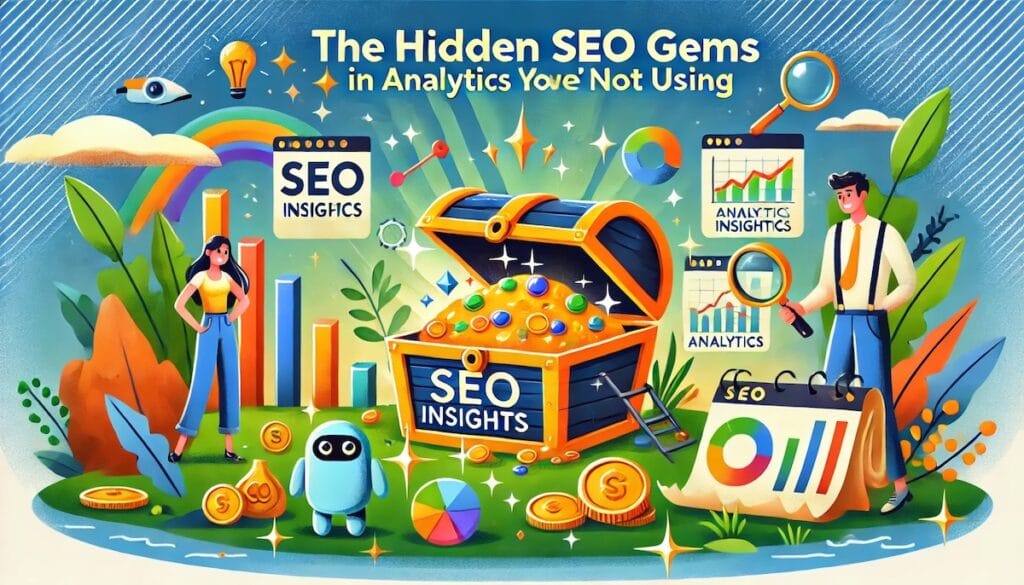Analytics is like a treasure map, but if you’re not reading it correctly, you’re missing out on the gold. Most website owners peek at their traffic numbers, nod solemnly, and close the dashboard. But buried within your analytics are hidden SEO gems waiting to be unearthed. These overlooked insights can supercharge your strategy and leave your competitors wondering what magic spell you cast.
Let’s dig in, shall we?
1. Bounce Rate Breakdown: The Tale of the Fickle Visitor
A high bounce rate isn’t just a slap on the wrist from Google—it’s a signal that your visitors aren’t loving what they see. Dive into your analytics and identify pages with the highest bounce rates. Are these pages loading too slowly? Is the content irrelevant? Or is your call-to-action buried in the abyss?
Fixing these issues can keep visitors engaged longer and boost your rankings. Think of your bounce rate as your website’s silent scream for help.
2. Site Search Queries: What Are Visitors Really Looking For?
If your website has a search bar, congratulations! You have a direct line to your visitors’ thoughts. Site search queries reveal what your audience is looking for but can’t find. This insight is a goldmine for content creation.
For example, if people keep searching for “pricing” but your pricing page is buried in the footer, it’s time to make that page shine. Use these queries to optimize navigation and create content that matches your audience’s needs.
3. Exit Pages: The Breakup Texts of Your Website
Exit pages are where visitors decide to leave your website. These pages often hold clues about what’s not working. Are users exiting after reading a blog post because there’s no clear next step? Is your contact page a dead end?
Optimize these pages by adding strong internal links, clear calls-to-action, or even enticing offers. Make it hard for visitors to leave without exploring more.
4. Geographic Insights: Speak to Your Audience’s Locale
Your analytics likely tell you where your traffic is coming from geographically. Are you optimizing your content for these regions? For instance, if you’re getting a lot of traffic from Australia but your blog is full of U.S.-specific references, you’re missing a chance to connect.
Localize your content, add relevant keywords, and consider creating region-specific landing pages. It’s like speaking someone’s language—instant rapport.
5. Referral Traffic: Who’s Talking About You?
Referral traffic is the friend who sets you up on a great blind date. It tells you which external sites are driving visitors to yours. Identify your top referrers and analyze what’s working. Is it a guest post you wrote? A backlink from a niche site?
Double down on what’s driving traffic by nurturing these relationships or replicating the strategy elsewhere. Referrals are a trust badge in the eyes of both users and search engines.
6. Behavior Flow: The Map of Visitor Wandering
Behavior flow shows you how visitors navigate through your site. It’s like a virtual GPS of your audience’s journey. Where do they go after landing on your homepage? Which pages lose their interest?
Use this insight to refine your user journey. Highlight popular paths and make them even smoother. If users frequently drop off after visiting a certain page, it’s time to revamp that page.
7. Mobile vs. Desktop: Are You Treating Mobile Right?
Analytics can tell you how your site performs on mobile versus desktop. If mobile visitors are bouncing more than desktop users, your site might not be as mobile-friendly as you think. Slow loading time, tiny fonts, or broken elements on mobile can hurt your rankings and frustrate users.
Fix these issues ASAP. Mobile-first indexing means Google is judging you by your mobile experience, so make it count.
8. Time on Page: Quality Over Quantity
Time on page is a direct indicator of how engaging your content is. If visitors are spending less than 10 seconds on a 2,000-word blog post, something’s off. Compare time on page across your site to identify winners and losers.
Boost engagement by making your content more readable: use subheadings, bullet points (yes, like this), and multimedia like images or videos to keep readers hooked.
9. Keyword Rankings: The Silent Shifters
Google Search Console is your ally here. Track how your keywords are performing over time. Are certain keywords climbing while others are dropping? Align this data with your analytics to see which pages need love.
Update underperforming pages with fresh content, better CTAs, or optimized keywords. SEO is not a set-it-and-forget-it game.
10. Event Tracking: Measure What Matters
Event tracking lets you measure specific user interactions, like clicks on a button, video plays, or downloads. If you’re not using this feature, you’re flying blind on how users interact with your site.
Set up event tracking for key actions and analyze the data. Are users clicking your “Buy Now” button but not completing the purchase? Are they abandoning your form halfway? Use this intel to optimize these actions and convert more visitors.
Conclusion
Your analytics dashboard is more than just numbers—it’s a window into your website’s soul. By uncovering and acting on these hidden SEO gems, you’ll transform your site from “meh” to magnificent in Google’s eyes.
So grab that treasure map, start exploring, and watch your rankings soar. Your competitors won’t know what hit them!









